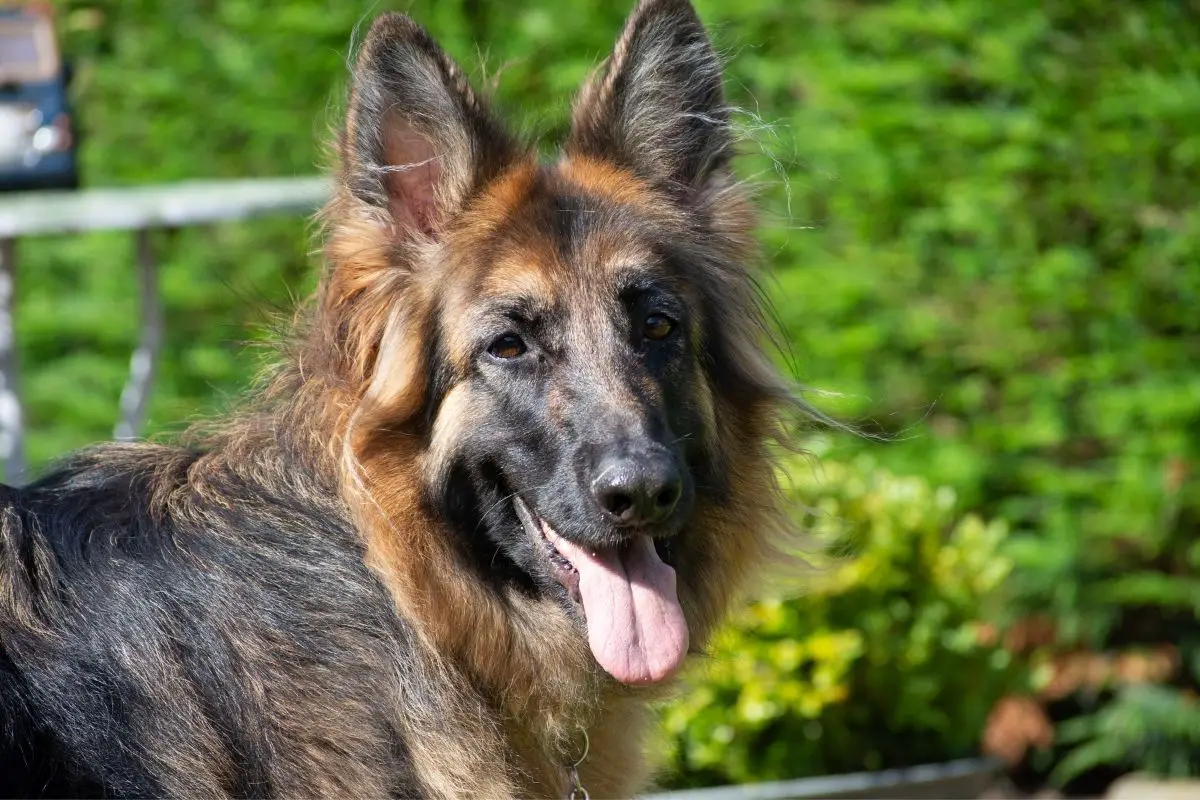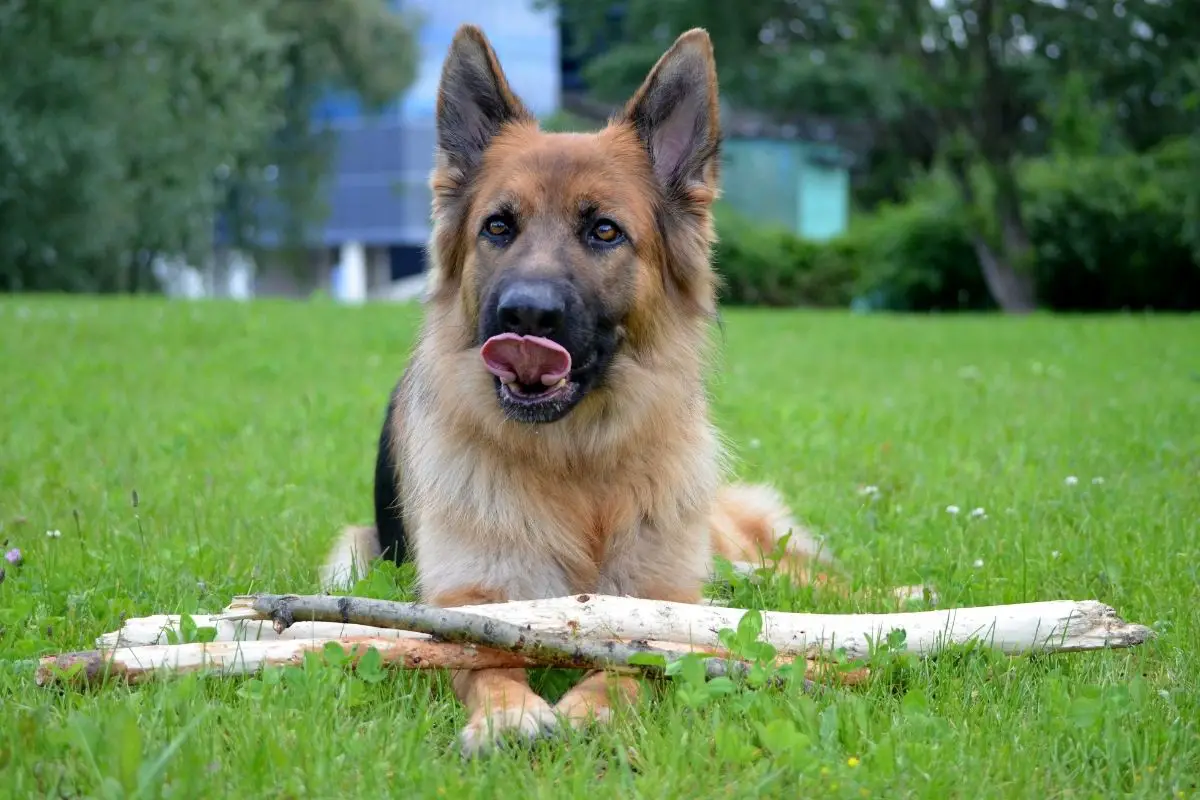Dwarfism is a condition well known to humans – but it also occurs elsewhere in the animal kingdom.
German shepherds tend to grow into a large breed once they reach adulthood – but every so often you’ll come across one that seems to be much smaller.
So you’re wondering what the deal is when it comes to Dwarf German Shepherd Dogs?
Well, here’s some information on how dwarfism affects dogs, and how you’ll be able to best care for your dog if you think it might have this condition.
We’ve also made sure to include a short FAQ section that will aim to answer any additional questions you might have around this issue.
Contents
- 1 What Is Dwarfism?
- 2 Causes Of Dwarfism
- 3 Other Causes
- 4 How To Care For Your Dwarf Dog
- 5 Treatments For Dwarfism
- 6 Preventing Future Complications in Dwarf German Shepherds
- 7 Mortality Of A Dwarf German Shepherd
- 8 German Shepherds (A History)
- 9 Training Tips
- 10 Frequently Asked Questions
- 10.1 What Is The Best Thing To Feed A German Shepherd?
- 10.2 How Much Exercise Should A German Shepherd Receive?
- 10.3 Are Dwarf German Shepherds Prone To Certain Diseases?
- 10.4 Is It Safe To Leave My German Shepherd Alone In The House?
- 10.5 Can I Train My German Shepherd From Birth?
- 10.6 Do Dwarf German Shepherds Shed?
- 10.7 What Is Pituitary Dwarfism?
- 10.8 What Is A Genetic Condition?
- 11 Final Thoughts
What Is Dwarfism?
The term “dwarf” refers to any dog with a body size that’s significantly shorter than average, or even below average for their breed.
A dwarf can have an extremely short tail (less than 10 inches long), a tiny head, small eyes, and a very thin build. In some cases, a dwarf may not look like a typical puppy at all!
Some breeds are naturally more prone to developing dwarfism than others.
For example, dogs from the Pekingese and Shih Tzu breeds are especially likely to develop this problem. Other factors include diet, health issues, and exercise.
If your dog has been diagnosed as having dwarfism, there are several things you should know about how to care for them.
First, you need to understand what causes dwarfism. Then, you’ll want to learn if your dog needs surgery or other medical treatment.
Finally, you’ll want to find out whether there are any behavioral problems associated with being a dwarf.
Causes Of Dwarfism
There are two main types of dwarfism: skeletal and soft tissue. Skeletal dwarfism affects the bones themselves, while soft tissue dwarfism involves the muscles, ligaments, skin, and organs.
Skeletal dwarfism is the most common type of dwarfism. It’s caused by a genetic mutation that results in abnormally shaped bones. This can happen when a gene responsible for bone growth is mutated.
Dogs who inherit this mutation will usually show symptoms within the first year of life. They may appear normal until they’re around six months old, then suddenly become noticeably stunted.
Their legs and hips may appear longer than usual, and their bodies may be bent over.
Soft tissue dwarfism is less common than skeletal dwarfism, but it does exist. It’s caused by abnormal development of the connective tissues that hold the skeleton together. These tissues are called ligaments, tendons, and fascia.
Ligamentous dwarfism tends to occur later in life after the bones have fully developed. Symptoms include joint laxity, muscle weakness, and pain.
Other Causes
In addition to these two main forms of dwarfism, there are many other possible causes of dwarfism in dogs. Some of these include:
- Genetic disorders such as osteogenesis imperfecta (brittle bone disease) and chondrodysplasia punctata.
- Diseases such as hypothyroidism, hyperadrenocorticism, and diabetes mellitus.
- Trauma, including fractures and luxations.
- Nutritional deficiencies, including vitamin D deficiency and copper toxicosis.
- Illnesses, including heartworm infection, Lyme disease, and cancer.
- Environmental toxins, including lead poisoning.
How To Care For Your Dwarf Dog
Once you’ve determined that your dog has dwarfism, you’ll need to decide on a course of action.
If your dog was born with dwarfism, you’ll probably want to treat him/her right away. However, if your dog was born without dwarfism, you may still want to take steps to prevent future complications.
Treatments For Dwarfism
The best way to manage dwarfism is to catch it early. That means making sure your dog gets plenty of exercise, good nutrition, and regular veterinary visits.
You also should make sure he doesn’t suffer from any underlying diseases that could cause his condition to worsen.
If your dog was born with the condition, you’ll probably want him to undergo corrective surgery.
Most veterinarians recommend that dwarf dogs get hip dysplasia surgery before they reach 12 months of age.
Hip dysplasia occurs when the ball-shaped socket of the hip joint becomes misaligned. This causes the leg to bend inwardly, causing lameness or even collapse.
Surgery corrects the problem by realigning the hip joint.
If your dog was born without the condition, you might consider getting him spayed or neutered.
Spaying and neutering reduce the risk of certain cancers and lowers the chance of developing reproductive problems.
You may also want to consult a veterinarian about medications that could help improve your dog’s health.
These drugs include glucosamine supplements, which can strengthen joints; anti-inflammatory medications like aspirin and ibuprofen, which reduce inflammation; and thyroid medication, which helps regulate metabolism and energy levels.
Preventing Future Complications in Dwarf German Shepherds
Even though your dog may not have been born with dwarfism, he may develop the condition at some point in his lifetime.
In this case, you’ll want to do everything you can to avoid further complications. Here are some things you can do to keep your dog healthy:
Keep an eye out for symptoms of illness. If your dog shows signs of illness, contact your vet immediately.
He may be able to prescribe antibiotics or another treatment to cure the problem.
Take care of your dog’s teeth and gums. Brushing your dog’s teeth twice a week will help remove plaque and tartar buildup. Keeping his teeth clean also prevents gum infections.
Make sure your dog gets enough exercise. Exercise increases blood flow, which improves oxygenation throughout the body. This makes your dog more resistant to illnesses and injuries.
Give your dog nutritious food. A diet high in protein and low in fat is ideal. Foods rich in fiber and vitamins also promote good health.
Don’t let your dog drink tap water. Tap water contains chemicals that can damage your pet’s kidneys, liver, and other organs. Instead, fill up a bowl of fresh water every day.
When it comes to caring for your dog, there are many ways to go about it. By following these tips, you’ll ensure that your pet stays happy and healthy.
Mortality Of A Dwarf German Shepherd
You may be wondering how long a dwarf German shepherd can live. Do they have any complications that cause their lifespan to be less than a regular German Shepherd?
The unfortunate answer is yes. Several factors affect the life expectancy of a dwarf German shepherd. Some of them include:
Genetics
Your dog’s genetics play a large role in determining his lifespan. For example, if both parents were dwarfs, then there is a 50% chance that one of their offspring will be a dwarf as well.
Breed
Certain breeds tend to live longer than others. For instance, the Labrador Retriever lives approximately 15 years while the Pekingese only lives around 8 years.
Medical Conditions
Medical problems can shorten a dog’s lifespan. Common examples include hip dysplasia, epilepsy, and allergies.
German Shepherds are known for being loyal and hardworking dogs. They’re also very intelligent and trainable. But did you know that German Shepherds are part of a larger group of herding dogs called the Spitz family?
German Shepherds (A History)

This page provides general information about the German Shepherd Dog breed. It includes basic facts about the history, physical characteristics, health issues, and typical activities of this popular dog breed.
History Of The German Shepherd
The German Shepherd was originally bred by the Germans during World War I to protect soldiers from enemy attacks. Today, the German Shepherd is still used to guard livestock and people.
Physical Characteristics
The German Shepherd has a thick coat with a double-layered undercoat. Its coat color varies depending on its parentage.
Most German Shepherds come in black, brown, red, tan, cream, white, fawn, blue, gray, or yellow colors.
Size And Weight
The average weight of a male German Shepherd is between 65 and 75 pounds and females weigh between 55 and 70 pounds. Their height ranges from 22 inches to 24 inches.
Temperament
It takes a lot of training to make a German Shepherd obedient. However, once trained, they are extremely devoted to their owners. They are highly energetic and alert.
Activity Level
They love to work and need lots of exercise. German Shepherds require daily walks and vigorous games like Frisbee and fetch.
Training Tips
If you want to get started with training your new puppy, here are some helpful tips:
Start Early
Puppies should start learning obedience skills at an early age. This helps them become more confident and independent later on.
Teach Commands Slowly
Don’t expect your puppy to understand everything right away. Start with simple commands such as “sit” and “stay.”
Reward Good Behavior
When your puppy does something good, give him a treat. If he misbehaves, ignore him. This is a fundamental concept to the modern training of dogs.
The idea is to guide your dog into creating good habits – rewarding them is one of the ways you can do this.
Keep Practicing
Practice commands over and over again until they get it right. Training a dog to replicate a certain behavior can take quite some time. Thankfully, dwarf German shepherds are quite an intelligent breed.
Frequently Asked Questions
Get your last-minute questions answered below before you leave us today!
What Is The Best Thing To Feed A German Shepherd?
Feeding a healthy diet is essential for all animals, including German Shepherds.
A well-balanced diet consists of high-quality protein, carbohydrates, vitamins, minerals, and water. Make sure that your German Shepherd’s food meets these requirements.
How Much Exercise Should A German Shepherd Receive?
Exercise is important for every animal, especially those who spend long periods of time indoors. Daily walks are recommended for all pets. Exercise increases energy levels and keeps your German Shepherd happy.
Are Dwarf German Shepherds Prone To Certain Diseases?
Yes, dwarf German Shepherds are susceptible to several conditions, including hip dysplasia, elbow dysplasia, allergies, and thyroid problems.
To help prevent these diseases, be sure to keep your dog up to date on his vaccinations and visit your vet regularly.
Is It Safe To Leave My German Shepherd Alone In The House?
Yes, it’s perfectly fine to let your German Shepherd stay inside when you’re not around.
However, make sure that he has access to plenty of fresh air and exercise. He may enjoy playing outside or watching TV.
Can I Train My German Shepherd From Birth?
Yes, you can begin training your puppy as soon as he comes into your life. It’s important to teach basic obedience skills such as sit, down, come, wait, and heel.
You can also teach other tricks, such as fetch, shake, roll over, and jump.
Do Dwarf German Shepherds Shed?
Yes, German Shepherds typically shed year-round. During the spring and summer months, their coats may become thicker and denser. This is normal, and there’s no need to worry about it.
What Is Pituitary Dwarfism?
Pituitary Dwarfism is a genetic disorder that causes a small-sized skull and body. Pituitary Dwarfism affects both male and female dogs, although males tend to develop the disease earlier than females.
What Is A Genetic Condition?
A genetic condition is caused by an inherited trait passed through genes from parents to offspring.
Final Thoughts
So there you have it! Dwarfism is a condition that can affect many different breeds of dogs, and German Shepherds are one of them!
Dwarf German Shepherds are still a great, loving pet – though they do require some additional health monitoring and care.
As with any new pet, make sure you are ready to take on a new responsibility, and that you have adequately researched what it will take to care for a Dwarf German Shepherd before taking one to your home!
We hope that this article has given you most of the information you’ll need to know about Dwarf German Shepherds, continue reading other articles pertaining to Dogs and Dog Breeders Here.



